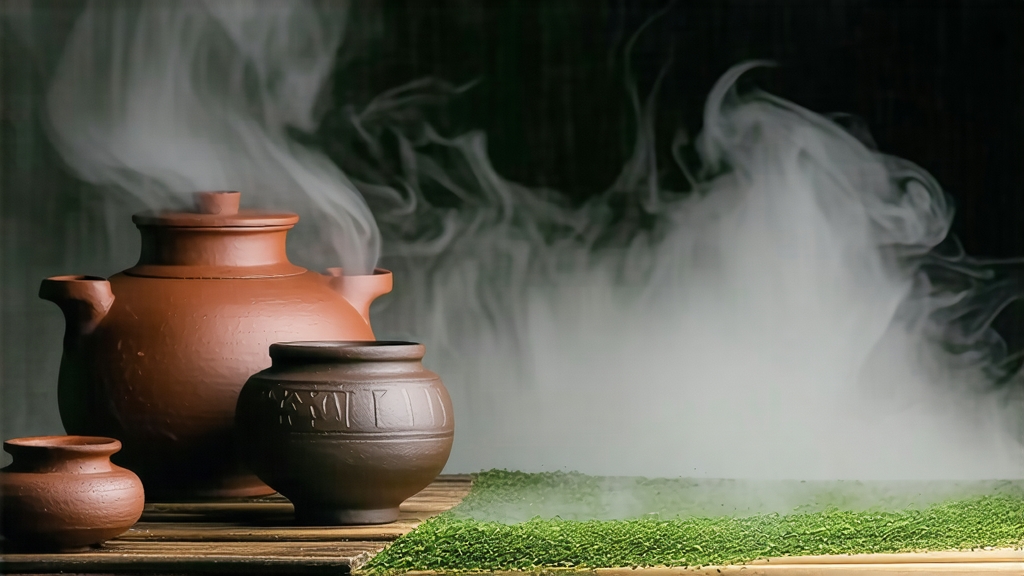
Tucked away in the humid, karst-pocked mountains of southern China’s Guangxi Zhuang Autonomous Region, Liu Bao tea has spent the last four centuries quietly fermenting its way into the hearts of dockworkers, emperors, and now, global tea aficionados. Often overshadowed by its more famous cousin Pu-erh, Liu Bao is the sleeper hit of the dark-tea family: a mellow, camphor-sweet liquor that carries the scent of damp earth, betel nut, and the memory of ancient trading routes. To understand Liu Bao is to follow the West River downstream from the misty Wuzhou docks to the humid storerooms of Hong Kong and, eventually, to your own teapot, where time and micro-organisms collaborate to brew something that tastes like history itself.
Historical currents
Liu Bao takes its name from the old administrative village of Liu Bao in Cangwu County, Wuzhou. During the Qing dynasty, the tea was compressed into 50-kilogram bamboo baskets and rafted down the West River to Guangzhou, then onward to Hong Kong and Southeast Asia. Dock coolies drank it to dispel dampness and fatigue; miners in Malaya swore it prevented malaria. By the late 19th century, Liu Bao had become a currency of the diaspora—so valuable that overseas Chinese in Kuala Lumpur pawned their watches for a basket of the 20-year-old leaves. The 1950s saw state-run factories standardize production, but the essential craft—ferment, steam, press, wait—remained unchanged. Today, vintage baskets from the 1970s fetch tens of thousands of dollars at auction, and new boutique workshops are reviving pre-Communist techniques, betting that the world is ready for a tea that tastes like the inside of an old Chinese medicine chest.
Varietal terroir
Guangxi’s subtropical climate and lateritic red soil breed a cultivar locally called “medium-leaf Yunnan-type,” a genetic cousin to Da Ye Zhong used for Pu-erh but acclimated to lower altitude and higher humidity. The picking window is narrow: one bud and three to four leaves after the early-spring rains, when the leaf’s cell walls are still pliable enough to withstand the rigorous piling to come. Leaves from higher elevations (300–600 m) carry more quartz-rich minerality, while valley bushes contribute broader, sweeter amino acids. The most sought-after micro-origin is the village of Tashan, where morning fog lingers until noon, feeding leaf-surface yeasts that will later sculpt the tea’s flavor.
Crafting darkness
Liu Bao belongs to the “wet-piled” school of dark teas (hei cha). After a brief sun-wither, the leaves are pan-fired at 180 °C to arrest oxidation, then rolled until the epidermis splits into tight cords. The critical step is “wo dui”—wet piling—where the leaf is heaped 70 cm high, misted with mountain spring water, and covered with jute sacks. Inside this compost-like mound, thermophilic bacteria (Bacillus subtilis), yeasts (Cyberlindnera jadinii), and golden mold (Aspergillus cristatus) raise the temperature to 55 °C within 24 hours. Every two days the pile is turned, aerated, and re-moistened; the process lasts 10–18 days depending on ambient humidity. When the leaf core turns walnut-brown and emits the scent of sweet wood, the pile is broken down, dried over pine-fired baskets, and left to “rest” for three months, allowing residual heat and moisture to equalize. Finally, the tea is steamed soft, packed into cylindrical bamboo baskets lined with banana leaves, and pressed by foot-driven stones. The bamboo imparts a faint green-grass note that will slowly oxidize into dried longan sweetness over decades.
Aging architecture
Unlike Pu-erh, which is often stored dry, Liu Bao prefers the humid breath of southern China. Traditional warehouses in Wuzhou open their louvered windows to the monsoon, maintaining 75–85 % relative humidity and 25–30 °C. In these conditions, the tea undergoes secondary fermentation: starch converts to ribose, proteins break into savory peptides, and a rare compound—(E)-2-octenal—emerges, giving aged Liu Bao its signature aroma of betel nut and camphor. Connoisseurs speak of three aging milestones: “new” (